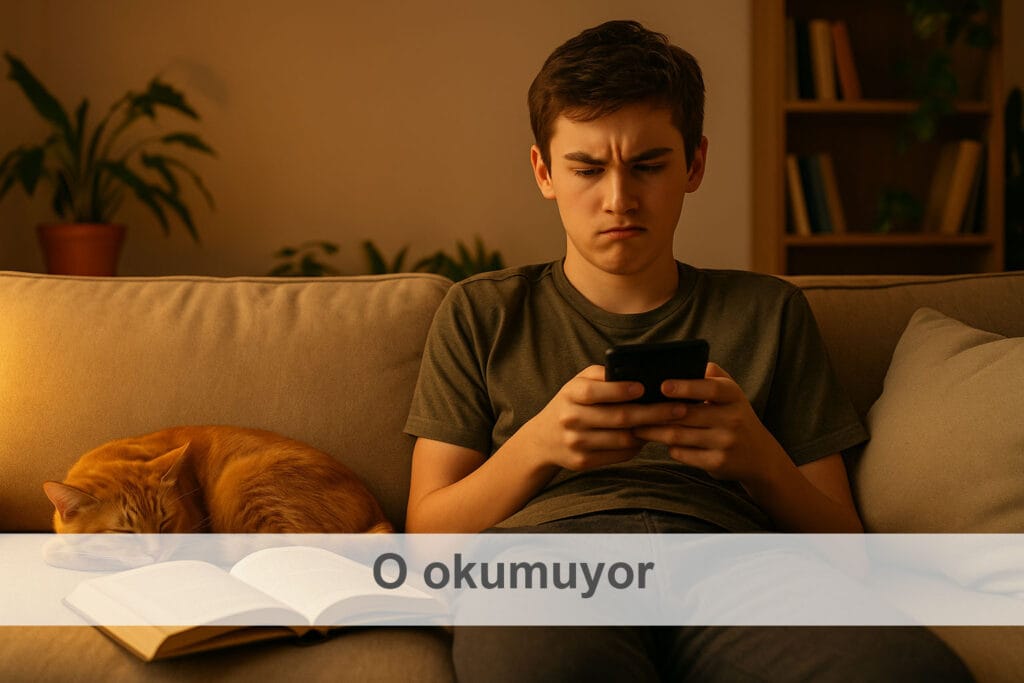Şimdiki Zaman (Present Continuous Tense in Turkish)
The Şimdiki Zaman tense is used in Turkish to talk about:
- actions happening right now, at the moment of speaking
e.g. Ben kitap okuyorum. → I am reading a book. - actions happening around the current time, even if not exactly this second
e.g. Bu günlerde çok çalışıyorum. → I am working a lot these days. - sometimes for near-future plans or arrangements (though less commonly than in English)
e.g. Yarın arkadaşlarımla buluşuyorum. → I am meeting my friends tomorrow.
Time expressions often used with Şimdiki Zaman (Present Continuous Tense in Turkish):
Together with the Present Continuous Tense, words like these are often used:
asla → never
şimdi → now
bugün → today
bu gece → tonight
bu hafta → this week
genel olarak → generally
her gün → every day
her hafta → every week
her zaman → always
şu anda → at the moment
sık sık → often
genellikle → usually
Affirmative Form of Şimdiki Zaman (Present Continuous Tense in Turkish)
How to Form Şimdiki Zaman (Present Continuous Tense) in Turkish
The Present Continuous Tense (Şimdiki Zaman) in Turkish is formed by adding the suffix -yor to the verb stem, followed by the personal ending.
The vowel before -yor changes according to vowel harmony (ünlü uyumu) rules:
- If the last vowel in the verb stem is a or ı, add –ıyor
- yazmak → yazıyor → He/She is writing
- If the last vowel is e or i, add –iyor
- gelmek → geliyor → He/She is coming
- If the last vowel is o or u, add –uyor
- okumak → okuyor → He/She is reading
- If the last vowel is ö or ü, add –üyor
- görmek → görüyor → He/She is seeing
Vowel Dropping Rule in Şimdiki Zaman (Present Continuous Tense in Turkish)
If the verb stem ends with a vowel, that vowel is dropped before adding the -yor suffix. This happens because in Turkish, two vowels usually cannot stand next to each other.
So, the final vowel of the stem is removed to avoid two vowels coming together.
Examples:
beklemek (to wait) → bekle + iyor → bekliyor → (he/she is waiting)
söylemek (to say) → söyle + üyor → söylüyor → (he/she is saying)
oynamak (to play) → oyna + uyor → oynuyor → (he/she is playing)
This is called the vowel contraction rule or simply vowel dropping.
Consonant and Vowel Changes in Şimdiki Zaman (Present Continuous Tense in Turkish)
Change of -t to -d
If the verb stem ends with -t (such as git-, et-, tat-, güt-), the final t changes to d before adding the -yor suffix.
Examples:
gitmek (to go) → gidiyor → (he/she is going)
tatmak (to taste) → tadıyor → (he/she is tasting)
etmek (to do/make) → ediyor → (he/she is doing/making)
gütmek (to herd) → güdüyor → (he/she is herding)
Change of e → i in some monosyllabic verbs
For certain short verbs like yemek (to eat) and demek (to say), the vowel e changes to i in the present continuous tense.
Examples:
yemek → yiyorsun → (you are eating)
demek → diyoruz → (we are saying)
Personal Endings in Şimdiki Zaman (Present Continuous Tense)
| Personal Ending | Example in Turkish | Translation |
|---|---|---|
| –um | Ben okuyorum | I am reading |
| –sun | Sen okuyorsun | You are reading (singular) |
| – | O okuyor | He/She is reading |
| –uz | Biz okuyoruz | We are reading |
| –sunuz | Siz okuyorsunuz | You are reading (plural/formal) |
| –lar | Onlar okuyorlar | They are reading |

O okuyorNegative Form of Şimdiki Zaman (Present Continuous Tense in Turkish)
- To form the negative, you add the negative particle -ma- / -me- to the verb stem.
- After that, you add the continuous tense suffix -yor.
- Then you add the personal ending.
- However, -ma- / -me- changes depending on vowel harmony. It becomes:
| Last vowel in the stem | Negative suffix | Example |
|---|---|---|
| a, ı | mıyor | bakmak → bakmıyor (is not looking) |
| e, i | miyor | bilmek → bilmiyor (does not know) |
| o, u | muyor | okumak → okumuyor (is not reading) |
| ö, ü | müyor | görmek → görmüyor (is not seeing) |
So, -ma- / -me- turns into -mı- / -mi- / -mu- / -mü- before -yor according to vowel harmony rules.
Examples:
görmek → görmüyor (is not seeing) → stem “gör-”, last vowel “ö” → add -mü-yor → görmüyor
bakmak → bakmıyor (is not looking) → stem “bak-”, last vowel “a” → add -mı-yor → bakmıyor
bilmek → bilmiyor (does not know) → stem “bil-”, last vowel “i” → add -mi-yor → bilmiyor
okumak → okumuyor (is not reading) → stem “oku-”, last vowel “u” → add -mu-yor → okumuyor
Examples
okumak – to read | Example |
oku + m + uyor + um | Ben okumuyorum – I am not reading |
oku + m + uyor + sun | Sen okumuyorsun – You are not reading |
oku + m + uyor | O okumuyor – He/She is not reading |
oku + m + uyor + uz | Biz okumuyoruz – We are not reading |
oku + m + uyor + sunuz | Siz okumuyorsunuz – You are not reading |
oku + m + uyor + lar | Onlar okumuyorlar – They are not reading |

Interrogative form of the verb in the present continuous tense (ŞİMDİKİ ZAMAN)
The interrogative form is formed by adding the separate particle mı / mi / mu / mü after the verb in the -yor tense. The particle harmonizes according to vowel harmony. After the particle, a personal pronoun word is added (it does NOT merge with the verb but stands separately).
Verb + YOR + mı/mi/mu/mü + personal pronoun
Features of using the question particle in the present continuous tense (ŞİMDİKİ ZAMAN)
In Turkish, two vowels cannot appear side by side in writing, so a consonant “y” is inserted between them:
→ mu + um → muyum
The question particle in the present continuous tense is always “mu,” because the vowel “o” in the tense suffix -yor dictates vowel harmony rules.
The question particle is always written separately from the verb!
geliyormusun – incorrect
geliyor musun? – correct
Special case: 3rd person plural
In the 3rd person plural, the personal ending (-lar) is attached to the verb, and the question particle mı stands separately.
Example:
→ Onlar biliyorlar mı? – Do they know?
(not “biliyor mu” because the plural marker -lar must remain on the verb itself)
- Geliyor musun? – Are you coming?
- Yazıyor mu? – Is he/she writing?
- Bekliyor muyuz? – Are we waiting?
- Gidiyor musunuz? – Are you going? (plural/formal)
- Yüzüyorlar mı? – Are they swimming?
okumak – to read | |
oku + uyor mu + y + um | Ben okuyor muyum? – Am I reading? |
oku + uyor mu + sun | Sen okuyor musun? – Are you reading? |
oku + uyor mu | O okuyor mu? – Is he/she reading? |
oku + uyor mu + y + uz | Biz okuyor muyuz? – Are we reading? |
oku + uyor mu + sunuz | Siz okuyor musunuz? – Are you reading? (plural/formal) |
oku + uyor + lar mı | Onlar okuyorlar mı? – Are they reading? |

Siz okuyor musunuz?Interrogative-Negative Form of the Verb in the Present Continuous Tense (Şimdiki Zaman)
The interrogative-negative form is used to ask negative questions, often to express surprise, doubt, or emphasis — similar to English questions like “Aren’t you…?” or “Isn’t he…?”
How it’s formed:
→ Verb stem + negative suffix (-mıyor / -miyor / -muyor / -müyor) + question particle (mı / mi / mu / mü) + personal ending
- The negative suffix changes according to vowel harmony.
- The question particle is written separately and also follows vowel harmony.
Examples:
- Gel + miyor + mu + sun? → Gelmiyor musun? → Aren’t you coming?
- Bil + miyor + mu? → Bilmiyor mu? → Doesn’t he/she know?
- Oku + muyor + muyuz? → Okumuyor muyuz? → Aren’t we reading?
- Git + miyor + musunuz? → Gitmiyor musunuz? → Aren’t you (plural/formal) going?
- İç + miyor + lar + mı? → İçmiyorlar mı? → Aren’t they drinking?
Ben okumuyor muyum? | Am I not reading? |
Sen | Aren’t you reading? |
O | Isn’t he/she reading? |
Biz | Aren’t we reading? |
Siz | Aren’t you reading? (plural/formal) |
Onlar | Aren’t they reading? |

Onlar okumuyorlar mı?Discover more from Turkish language
Subscribe to get the latest posts sent to your email.




